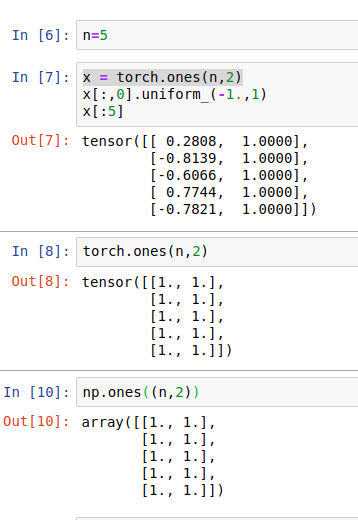I think it is making x an nx2 tensor (array), then setting the first column to be sampled from a uniform distribution on [-1, 1]
Right, but I don’t understand the x[:,0] syntax.
In that case I believe it’s just a matter of time…
Specifically in the first column.
Jeremy is explaining it now.
: means select all rows,0 selects first column
Reads to me as follows,
First create a tensor of 1s with n rows and 2 cols.
Then uniformly distribute the first col between -1 and 1. (hence overwriting it, _ is a in place operation suffix)
all rows in column 0
what’s the difference between np.ones or torch.ones if there is any?
We use pytorch because numpy isn’t compatible with a GPU.
It’s being explained now.
x = torch.ones(100, 2) creates a 2x100 matrix where every single value is a 1
The x[:,0] means “every single row of column zero” - and the uniform_ function ends in a _ which means that it must run an in-place replacement.
x[:,0].uniform_(-1.,1) = replace column zero of every row with a uniform value selected between -1 and 1
np.ones belongs to numpy library torch.ones belongs to torch library (as far as I understand). May be they are the same code-base - I don’t know 
Numpy (in general, matrix prog. lang.) syntax.
thanks. that’s a much better answer. are they (np array and torch tensor) structurally (axes, ndim, whatever) different?
torch.ones(n,2)
is it a rank 2 tensor ?
PyTorch has implemented some of the same functionality as Numpy. As Sylvain said, however PyTorch takes advantage of the GPU (offering speedups), which Numpy does not
yes it is
Sylvain being the first name of @sgugger 
does it mean even if I do matrix-vector multiplication using numpy, it will not take advantage of GPU?
